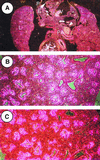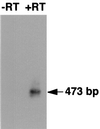Developmental expression of latent transforming growth factor beta binding protein 2 and its requirement early in mouse development
- PMID: 10848613
- PMCID: PMC85939
- DOI: 10.1128/MCB.20.13.4879-4887.2000
Developmental expression of latent transforming growth factor beta binding protein 2 and its requirement early in mouse development
Abstract
Latent transforming growth factor beta (TGF-beta) binding protein 2 (LTBP-2) is an integral component of elastin-containing microfibrils. We studied the expression of LTBP-2 in the developing mouse and rat by in situ hybridization, using tropoelastin expression as a marker of tissues participating in elastic fiber formation. LTBP-2 colocalized with tropoelastin within the perichondrium, lung, dermis, large arterial vessels, epicardium, pericardium, and heart valves at various stages of rodent embryonic development. Both LTBP-2 and tropoelastin expression were seen throughout the lung parenchyma and within the cortex of the spleen in the young adult mouse. In the testes, LTBP-2 expression was seen within lumenal cells of the epididymis in the absence of tropoelastin. Collectively, these results imply that LTBP-2 plays a structural role within elastic fibers in most cases. To investigate its importance in development, mice with a targeted disruption of the Ltbp2 gene were generated. Ltbp2(-/-) mice die between embryonic day 3.5 (E3.5) and E6.5. LTBP-2 expression was not detected by in situ hybridization in E6.5 embryos but was detected in E3.5 blastocysts by reverse transcription-PCR. These results are not consistent with the phenotypes of TGF-beta knockout mice or mice with knockouts of other elastic fiber proteins, implying that LTBP-2 performs a yet undiscovered function in early development, perhaps in implantation.
Figures










References
-
- Cleary E G. The microfibrillar component of the elastic fibers. Morphology and biochemistry. In: Uitto J, Perejda A J, editors. Connective tissue disease. Molecular pathology of the extracellular matrix. New York, N.Y: Marcel Dekker, Inc.; 1987. pp. 55–81.
-
- Dickson M C, Martin J S, Cousins F M, Kulkarni A B, Karlsson S, Ackhurst R J. Defective hematopoiesis and vasculogenesis in transforming growth factor-beta 1 knockout mice. Development. 1995;121:1845–1854. - PubMed
-
- Dietz H C, Cutting G R, Pyeritz R E, Maslen C L, Sakai L Y, Corson G M, Puffenberger E G, Hamosh A, Nanthakumar E J, Curristan S M, Stetten G, Meyers D A, Francomano C A. Marfan syndrome caused by a recurrent de novo missense mutation in the fibrillin gene. Nature. 1991;352:337–339. - PubMed
-
- Fahrenbach W H, Sandberg L B, Cleary E G. Ultrastructural studies on early elastogenesis. Anat Rec. 1966;155:563–576.
-
- Fang J, Li X, Smiley E, Francke U, Mecham R P, Bonadio J. Mouse latent TGF-β binding protein-2: molecular cloning and developmental expression. Biochim Biophys Acta. 1997;1354:219–230. - PubMed
Publication types
MeSH terms
Substances
Grants and funding
LinkOut - more resources
Full Text Sources
Other Literature Sources
Molecular Biology Databases
Miscellaneous
